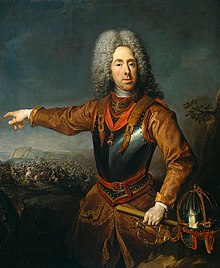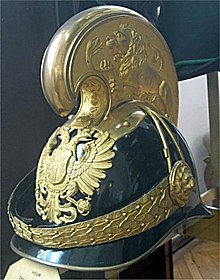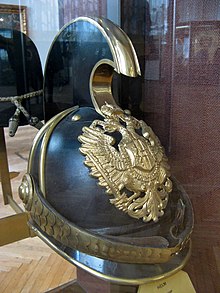kuk dragoons
The kuk dragoons formed the cavalry of the Austro-Hungarian army alongside the hussars and lancers . Due to the peculiarity of Austria-Hungary since 1867 to have in fact three armies existing side by side (when the monarchy, weakened by the lost war against Prussia, had to grant the Kingdom of Hungary its autonomy with the so-called settlement of March 15, 1867 , this led to it That the Hungarian half of the empire immediately began to set up its own army, the ku Landwehr "Királyi Honvédség" . Consequently, the cisleithan half of the empire also began to build a landwehr, the Imperial and Royal Landwehr - alongside which the Common Army existed.
In contrast to the hussars and lancers, there were no Landwehr units among the dragoons.
organization
The Joint Army had 15 dragoon regiments . Traditionally, the largest percentage of the dragoons were recruited from German and Czech-speaking areas. The regiments were all stationed in the cisleithan half of the empire.
The kuk cavalry regiments consisted of 2 divisions ( battalions ) each with 3 squadrons
The kuk dragoons
- Kuk Dragoon Regiment "Kaiser Franz I." No. 1
- Kuk Dragoon Regiment "Graf Paar" No. 2
- Kuk Dragoon Regiment "Friedrich August King of Saxony" No. 3
- Kuk Dragoon Regiment "Emperor Ferdinand I." No. 4
- Kuk Dragoon Regiment "Nicholas I Emperor of Russia" No. 5
- Kuk Dragoon Regiment "Friedrich Franz IV. Grand Duke of Mecklenburg-Schwerin" No. 6
- Kuk Dragoon Regiment "Duke of Lorraine" No. 7
- Kuk Dragoon Regiment "Count Montecuccoli" No. 8
- Kuk Dragoon Regiment "Archduke Albrecht" No. 9
- Kuk Dragoon Regiment "Prince of Liechtenstein" No. 10
- Kuk Dragoon Regiment "Kaiser" No. 11
- Kuk Dragoon Regiment "Nikolaus Nikolajewitsch Grand Duke of Russia" No. 12
- Kuk Dragoon Regiment "Eugene Prince of Savoy" No. 13
- Kuk Dragoon Regiment "Prince of Windisch-Graetz" No. 14
- Kuk Dragoon Regiment "Archduke Joseph" No. 15
uniform
- helmet
- The dragoons used the helmet as headgear, but this was replaced by the field cap during daytime duty in the barracks , during smaller field exercises, during squadron drill, etc. The helmets of the teams consisted of the helmet cap, the sun and neck umbrella, the comb, the forks and the helmet emblem. The helmet cap was made of black leather and was pressed in the shape of a hemisphere from one piece. The two umbrellas, painted black on the outside, were attached to the lower edge and connected to one another at the bottom. The comb was on top, the side parts were also painted black. Tinplate was used as the material for the umbrellas, the umbrella was green on the inside and the neck umbrella was painted black. Above the connection points there was a so-called water lace on both sides, 9 centimeters long and one centimeter upwards. The edges of the umbrellas were provided with a surrounding brass surround. The comb consisted of two comb blades and the cap rail made of black lacquered tinplate, and the comb rail and the comb cover made of sheet brass. The cap rail was curved three times on the outside and soldered to the lower edges of the comb blades. The comb rail, which covered the front concave and the comb top, which covered the upper and rear convex part of the comb, were connected to one another at the front at the tip. The comb rail was flat, whereas the comb top formed a round bar with a groove on both sides. The comb was attached to the helmet bowl with six hemispherical brass screws. On both sides of the helmet were the so-called forks (actually a device that was supposed to allow saber blows to slide off) which consisted of two brass legs, starting in a point on the comb blades and ending downwards to the left and right of the rosette .
- The scale band, used both as a decorative element and practically to hold the helmet in place, consisted of two parts, the left part of the buckle and the right part of the strap. Each of the two parts consisted of a rosette, the ribbon, 16 scales and a clasp. The straps were made of upper leather, rounded at the rear end and lined with sheepskin. The scale tape was flexibly attached to the screw nut of the rosette with an opening. Rosettes, scales and clasps were made of brass. The scales were rounded down alternately two and three times. The emblem in the form of the double-headed eagle was attached to the front in such a way that the crown lay at the lower end of the comb rail, the tip of the tail reached to the base of the parasol. The eagle wore a breastplate with the highest coat of arms and name , but no regimental number. In contrast, the helmet for the NCOs had a brass cap rail. The officers wore the comb, forks, scales ribbon, eagle and umbrella frame made of gold-plated metal on their helmets. There was an emblem on each of the two side leaves of the ridge, depicting a lion fighting a snake. The comb rail had the name FJI and an ornament. The scales of the ribbon consisted of matt embossed bay leaf tips with shiny berries. The two rosettes were designed as lion heads.
- Field cap
- The field cap was worn for work and light duty. It was made of madder red cloth and was made according to the pattern of the infantry, with the exception that the parasol was made of double cloth in the same color as the cap. Officers wore the infantry officer's field cap.
- Tunic
- The teams wore skirts in the same way as the foot troops, but without armpit braces or shoulder pads. On the left shoulder a so-called armpit loop made of double Attila cord was inserted into the seam, which could be buttoned into the small button 1.5 cm from the collar base. It was used to hold the strap of the revolver pouch. The collar and cuffs were covered with cloth in the equalizing color and, together with the white or yellow buttons, were used to distinguish regiments.
- Fur skirt
- The fur skirt was made of the same material as the tunic and was lined with white lambskin in the lap and body. On the front there were two rows of eight large skirt buttons each. The laps were moderately rounded at the front edges. In the extension of the back seam, there were two pocket flaps each with a button, the sleeves had cuffs at the ends in the equalizing color. Two cords were attached to the inside of the collar ends, one of which was made of light blue, square sheep's wool with the toggle on the right and the loop on the left. The second lanyard was made from Attila cords and was arranged according to the same pattern as the former. Officers were lined with black fur and the cords were made of black and gold mottled silk. The lap had a diagonally cut pocket with a curved flap at the front on both sides. On the back sides of the skirt double curly flaps with three skirt buttons each. The fur skirt was hung around the neck with the cords so that the stand-up collar did not fall over the shoulder.
- coat
- The cavalry cloak was dark brown in color and resembled that of the infantry in cut and shape. In contrast, it had a saber slot on the left side for teams too
- Boot pants
- The trousers, like the rest of the cavalry, were madder red in color. Cut wide in the buttocks, the calves were tight. A sloping pocket was let into each of the front legs. The pants could (the second pants or utility trousers had to ) be reinforced on the seat with matching pants fabric. Officers were allowed to wear saloon trousers made of fine, blue-gray cloth with madder-red passepoils - in cut and shape like the pantaloons of the infantry officers. The permission to carry only related to the office work and the time off duty.
- Boots
- “Budget” (standardized) cavalry boots, as worn by all mounted men, with the exception of the hussars.
Equalization of the dragoons regiments
| regiment | Button color | Leveling color |
|---|---|---|
| 1 | White | dark red |
| 2 | White | black |
| 3 | yellow | dark red |
| 4th | White | grass green |
| 5 | White | imperial yellow |
| 6th | yellow | black |
| 7th | White | sulfur yellow |
| 8th | yellow | scarlet |
| 9 | yellow | grass green |
| 10 | yellow | sulfur yellow |
| 11 | White | scarlet |
| 12 | yellow | imperial yellow |
| 13 | White | madder |
| 14th | yellow | madder |
| 15th | yellow | White |
Adjustment
- Parade adjustment for officers
- The dragoon officer had to appear on horseback with his helmet, in summer with a tunic and a fur coat slung around his neck (put on in winter), madder-red ankle trousers and cavalry boots. The cartouche and all decorations, medals and decorations , but the grand crosses had to be put on without ribbons. Arming according to regulations.
- On foot as described above, but the fur clothing was never allowed to be worn around the neck.
- Parade adjustment for NCOs and men
- On horseback the dragoons had to be fully equipped with a helmet and a tunic, or at the same time with a fur coat slung around his neck. The field devices were not carried. The coat had to be taken in summer only in doubtful weather, but always in rain. The horse was saddled and bridled in accordance with the regulations, pack sacks and menage bowls were not carried. The same rules applied on foot. Arming with the saber.
- March adjustment for officers
- The fur skirts were always carried along - put on or slung around the neck. The coat was always strapped to the saddle when not worn. If it rains in summer, the coat could be exchanged for the tunic, which then had to be strapped onto the saddle instead of the coat. Additional armament was the revolver and bag. A map case made of black-brown leather and binoculars could be carried.
- March adjustment for NCOs and men
- Similar to that of the officers, but without the separate pieces of equipment. Arming according to regulations.
Armament
- Firearms
- As standard, all cavalry regiments were equipped with the Mannlicher M 1895 bolt-action carbine with straight-pull piston lock and box magazine for five cartridges in the center shaft. This weapon wielded the four youngest corporals, mounted and unmounted dragoons, patrol leaders and driving soldiers - with the exception of the staff of the staff cavalry and the telegraph patrol. Officers wielded the officer's revolver , men and officers who were not assigned a rifle carried the Gasser Army revolver M 1870/74 . This was housed in a revolver pouch made of brown upper leather with a shoulder strap. As a rule, the paramedics, the bandage wearers, the butchers , the clerks, the blacksmiths , the gunsmiths and the squadrons were not armed with any firearms .
- Edged weapons
- The cavalry saber M 1869 was used as a saber . The officer's saber was similar to that of the men, but the handle was tied with silver-plated wire, and the basket was pierced, decorated and polished. The cavalry saber was prescribed for all officers, NCOs and men with the exception of the paramedics, butchers and driving soldiers, who wore the pioneer saber. The pouch belt was made of brown upper leather and had a length of 110 cm and a width of 5.3 cm. At the end of the buckle it had a widening that served as a base for the tinned roller buckle. The open end was tapered and had 5 pin holes. This belt was only used by the crews armed with revolvers. Because of the cartridge pouches, the strap was strapped around the body so that the clasp came to rest behind the left hip. For the riders equipped with carbines, the body strap had an additional strap that was used to fix this weapon on the body.
- Portepee
- The portepee of the cavalry officers was similar to that of the infantry officers, but had an additional push loop and was attached to the saber in the same way as the non-commissioned officers.
- The sergeants wore portepees made of imperial yellow and black sheep's wool on their sabers, while cadets wore portepees made of silk.
- Instead of the portepees, the teams carried saber hand straps made of red, yuchten-like leather, consisting of the hand strap with tassel and the two braided rings.
annotation
The Austrian (later Austro-Hungarian) cavalry regiment initially consisted of four, later of three divisions.
A division comprised three squadrons of two companies each in a cavalry regiment . The three divisions (battalions) of the regiment were (theoretically) led by the colonel, the lieutenant colonel and the major. This is where the name comes from. (The former 4th Division was referred to as the 2nd Majors Division.) In 1860–67 the cavalry regiments were again reduced to two divisions.
Until 1798, the regiments were named after their respective owners (who did not also have to be the commanders). There was no binding regulation of the spelling. (e.g. Count Serbelloni regiment - or Serbelloni regiment.) After 1798, the numbered designation prevailed, which could possibly be linked to the name of the owner. Due to this constant renaming, the regimental histories of the Austro-Hungarian cavalry are very difficult to follow. In addition, there is the constant and apparently arbitrary, sometimes multiple reclassification of the associations. (For example: Kuk Bohemian Dragoon Regiment "Prince of Windisch-Graetz" No. 14 )
In 1915, all honorary names were deleted without replacement. From then on, the units were only designated with their numbers (for example, "Dragoon Regiment No. 1"). However, this could not be enforced in practice, on the one hand because nobody adhered to it, on the other hand because the very thrifty Austro-Hungarian military administration had ordered all of them at first Use up any existing forms and stamps!
literature
- Johann C. Allmayer-Beck, Erich Lessing: The Kuk Army. 1848-1914 . Bertelsmann publishing house, Munich 1974, ISBN 3-570-07287-8 .
- The Austro-Hungarian Army in 1895 Writings from the Army History Museum in Vienna - Leopold Stocker Verlag , Graz 1997
- kuk war ministry “Dislocation and division of the kuk army, kuk navy, kk landwehr and ku landwehr” in: Seidel's small army scheme - published by Seidel & Sohn Vienna 1914
- Austro-Hungarian War Ministry "Adjustment regulation for the Austro-Hungarian Army, the Imperial and Royal Landwehr, the Imperial and Royal Landwehr, the affiliated institutions and the corps of military officials" Vienna 1911
Individual evidence
- ↑ according to “Announcement of the Quartermaster's Department” of Army Group Command FM. Archduke Eugen / Q.Op. No. 665/15. Issued by the field post office 512
Web links
- Homepage kuk Dragoon Regiment No.7, Linz / Danube
- Homepage kuk Dragoon Regiment No.3, King of Saxony
- Homepage Dragoon Regiment No.4 "Emperor Ferdinand"
- Homepage kuk Styrian-Carinthian-Carniolan Dragoon Regiment No. 5 - 2nd Squadron
- Glenn Jewison, Jörg C. Steiner: The Austro-Hungarian Land Forces 1848-1918








